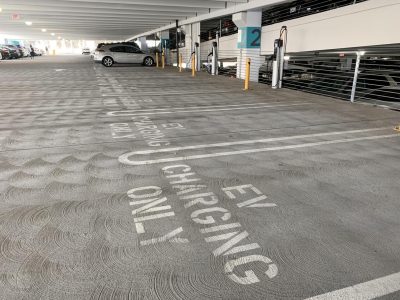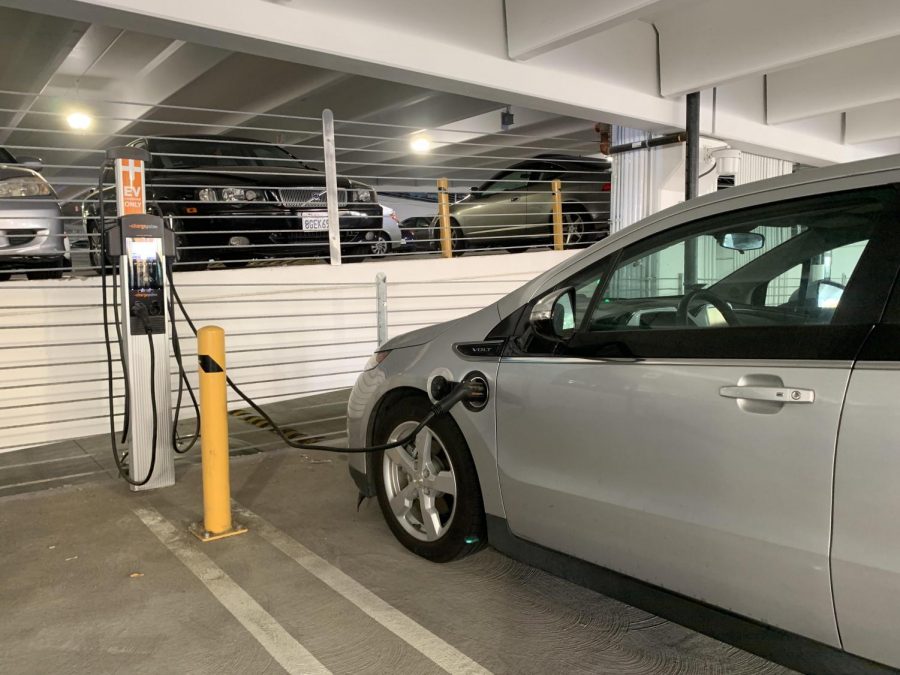Electric vehicles: How is Sac State accommodating newer cars?
Sac State to introduce more charging stations on campus
A Chevrolet Volt charges on campus in Parking Structure V. There is a maximum of $44 per charging session.
November 9, 2019
The popularity of electric vehicles is noticeable in California, a state which has the goal to put 5 million zero-emission vehicles on the road by 2030.
Sacramento State is part of the trend of electric vehicles growing in popularity and usage; at Sacramento State the recently-built Parking Structure V includes charging stations and designated parking spaces for electric vehicles.
Tony Lucas, senior director of University Transportation and Parking Services, said via email that Parking Structure V was “pre-wired for easy expansion of an additional 50 EV Charging Spaces for when the demand is present.”
Although UTAPS does not have an estimate of how many electric vehicles roam campus, Lucas did say that Sac State currently has, “65 Level II Charging Stations available to our campus community in four locations with plans to expand to three additional locations over this coming summer.”
Story continues below map
Currently, the rate to use a charging station is $1 per hour for up to four hours. After the four-hour limit, the rate becomes $10 per hour to discourage overtime usage and allow others to use the charging stations, according to Lucas.
Lucas said the majority of electric vehicles can receive a full charge within four hours at a Level II Charging Station.
When asked about whether he would feel comfortable transitioning from an internal combustion vehicle to an electric vehicle, Christian Lopez, a psychology major, said that if he had the money he would definitely buy an electric vehicle to help reduce the use of fossil fuels.
RELATED: OPINION: Sac State needs to be more cost-friendly towards electric vehicles
“I am not a car enthusiast,” Lopez said. “As long as it drives well and I have no problems with it, that is all I care about.”
Andrew Guerra, a physics major, said there is nothing that attaches him to his current car.
“Eventually, (electric cars) are going to be more common than regular cars,” Guerra said. “But I don’t think that is going to happen for another 10-20 years.”
Brett Holland, a biology professor at Sac State, owns a Tesla and uses the charging station at Parking Structure V.
Holland said that saving money on gas and maintenance repairs was a factor that led him to purchase an electric vehicle. “I couldn’t imagine buying a luxury gas car when I can have an electric car that pays me money back.”
Holland said that moving from a car with internal combustion to an electric vehicle is not a luxury because you are getting some of the car’s tag price back. Holland said he saves “20 cents a mile on gas and maintenance” and estimates he’s had $6,000 in total savings since he purchased his car 15 months ago.
Holland, however, did mention that if there is an improvement that Tesla can make to their cars, it would be improving the battery’s range so that people do not have to charge as often.
Story continues below photo

Ari Uzzle, a sociology major, said she would be comfortable switching from an internal combustion car to an electric vehicle because even though they are expensive she knows she would save money on gas; making it a good investment.
Russ Tatro, Department of Electrical and Electronic Engineering lecturer, said that a typical lifetime of a battery is “five to six years, at which point you don’t have the 300-mile range you started with.”
According to Tatro the batteries that electric vehicles use range from 60-kilowatt per hour to roughly 100-kilowatt per hour, however, the motor usually runs in the 20-kilowatt per hour. In addition, the battery must be within certain temperature levels as it would become inefficient when too hot or cold.
If you drive an electric vehicle you certainly do not want to wear out your battery replacing it can cost you upwards of $10,000 because lithium is too precious according to Tatro. The motor, however, can last forever if used within its regime.

































































































































